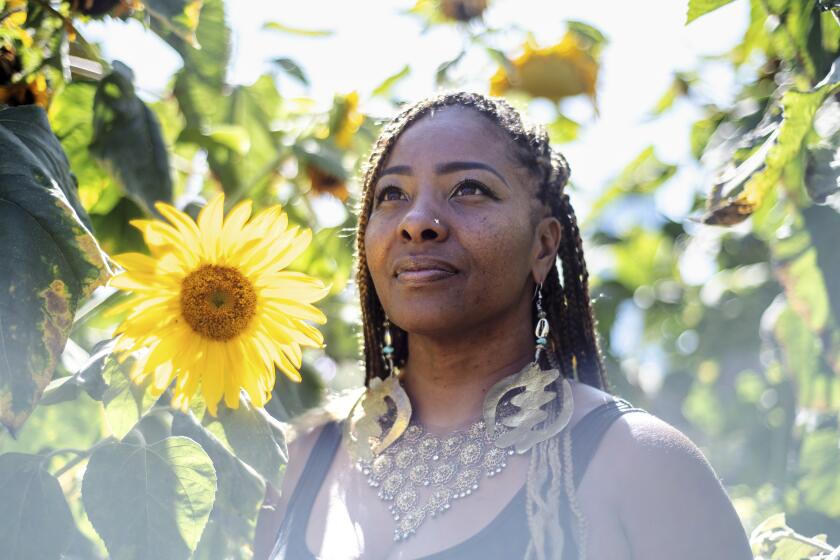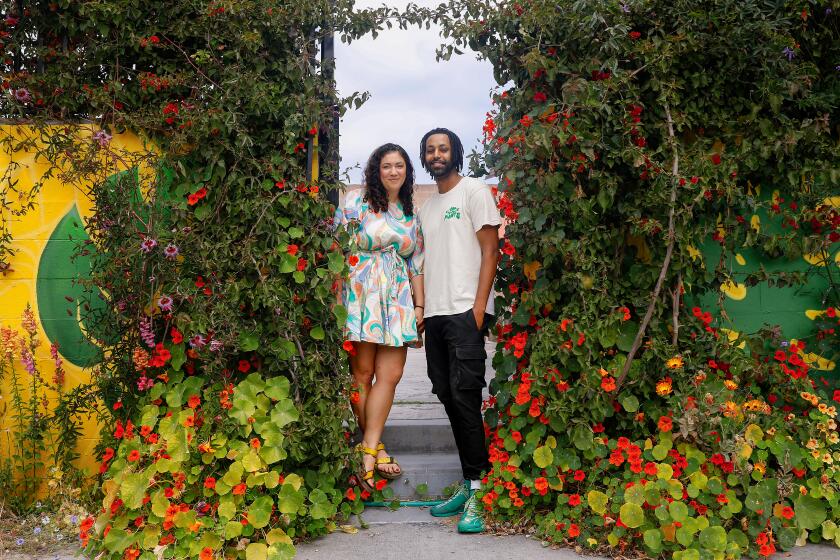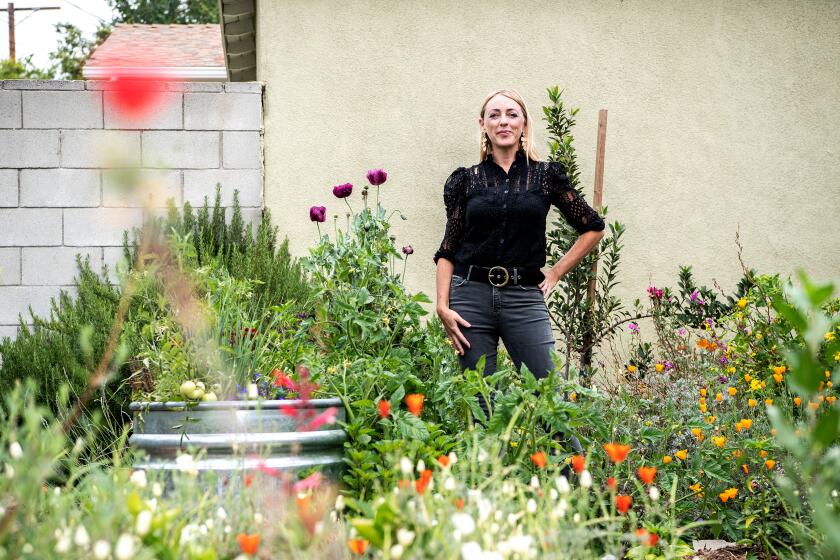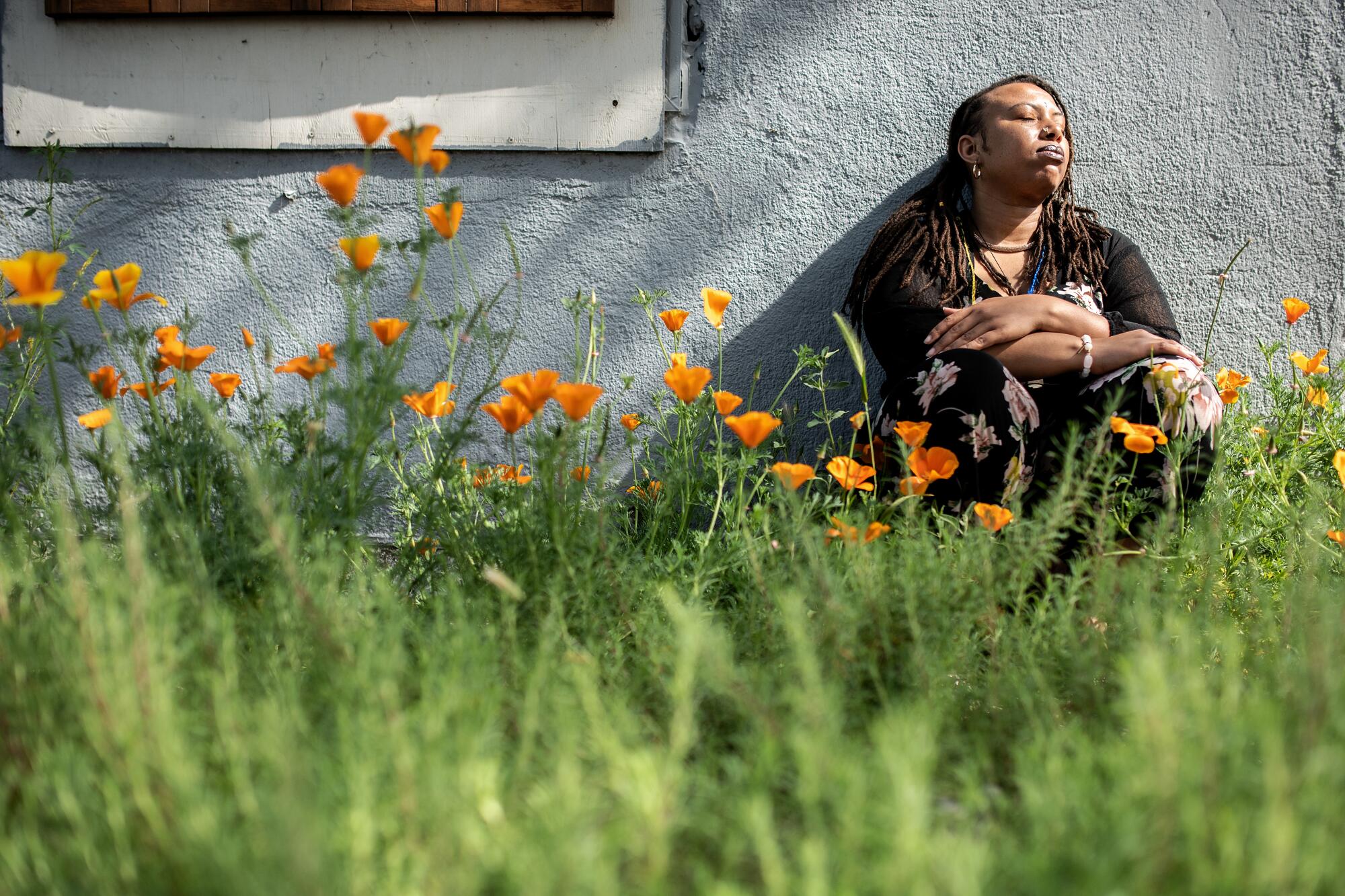
- Share via
Walking into the Survivors Healing Garden on 108th Street, just blocks from Watts Towers, Oya Sherrills radiates calm as she stops to pick up trash that has blown in from the Union Pacific railroad tracks nearby.
“This was a junkyard with cars all over the place,” she says, surveying the 3,150-square-foot plot of land that surrounds the office of the nonprofit Reverence Project.
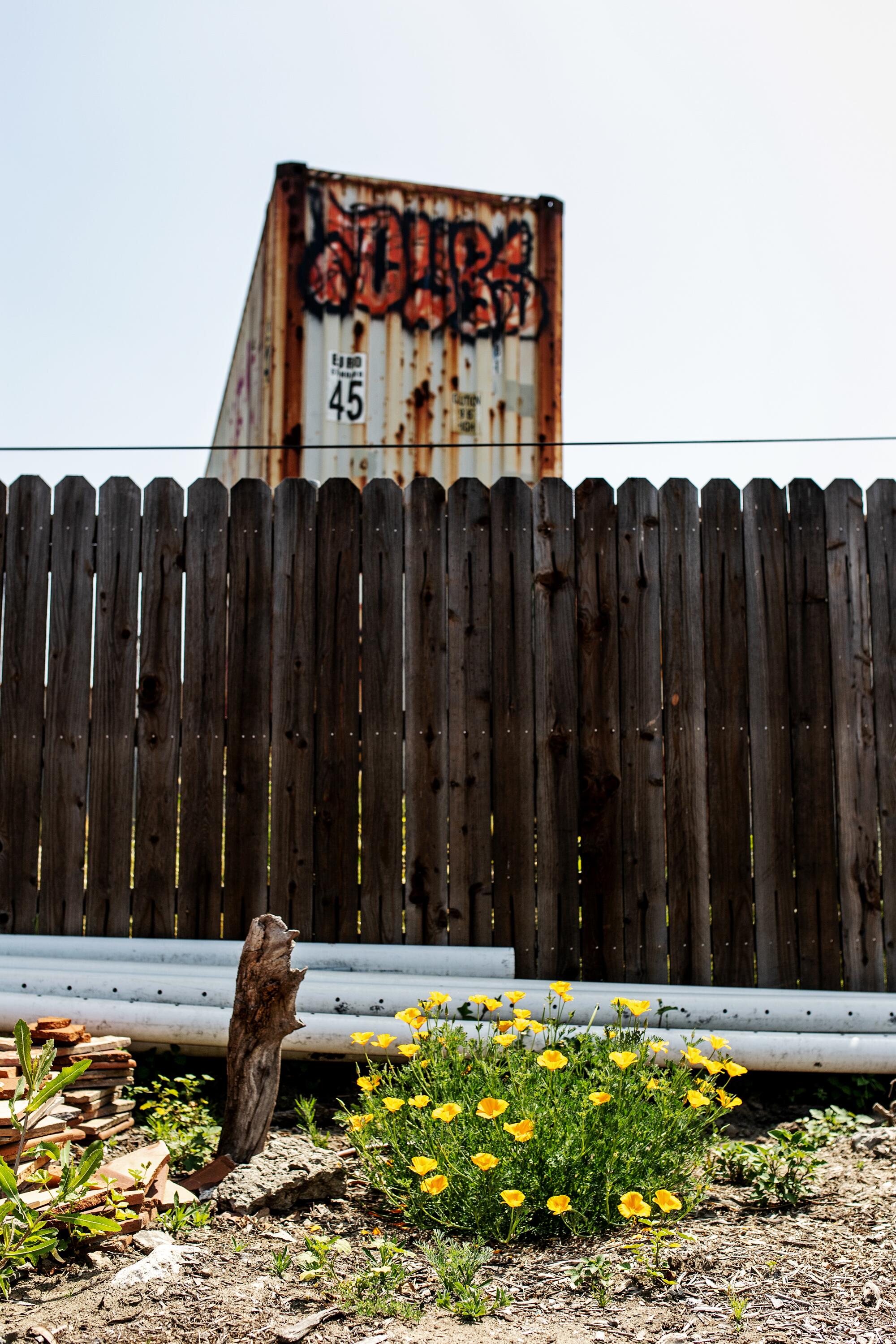
Beneath the cleared debris of the former junkyard, a garden is blooming with fragrant culinary herbs, newly planted trees and low-water California native plants.
As the project director of the Reverence Project, which offers healing services and support for survivors of violent crime, Sherrills has implemented many healing methods, in partnership with the city of Los Angeles’ Gang Reduction & Youth Development office, such as healing circles, talk therapy, massage therapy and yoga. Participants include peacemakers and crisis intervention workers who are skilled in de-escalating conflict and often struggle with post-traumatic stress disorder.
A survivor herself, Sherrills knows how parks and green space can benefit mental health struggles including depression and anxiety. Additionally, she has witnessed how green space can decrease violent behavior.
“I’ve utilized the garden to bring people’s tempers down,” she says. “I’ve seen people in the street having mental health crises, and when they come into the garden, their mood changes. When we make clear that nature needs to be a part of our healing journeys, we are making a new stand about how we are all connected, not just as people but to the Earth as well.”
Even in the garden’s infancy, there is little question it has made a difference since opening last June.
“You don’t see a lot of things like that here,” says Gisselle Meza, a 16-year-old podcast intern at the Reverence Project. “It’s all concrete and trash. It’s nice to look around and see trees and flowers blooming.”
Plants sustained Genea Richardson in prison and led to a job after she got out. She now trains formerly incarcerated people to work in landscaping.
This community may be the hardest-hit place in Los Angeles in terms of density and lack of green space. Despite being twice as dense as the city of Los Angeles, Watts has just 0.65 parks per 1,000 residents, according to the U.S. Green Building Council-Los Angeles, which donated $20,000 to the garden last year as its annual Legacy Project.
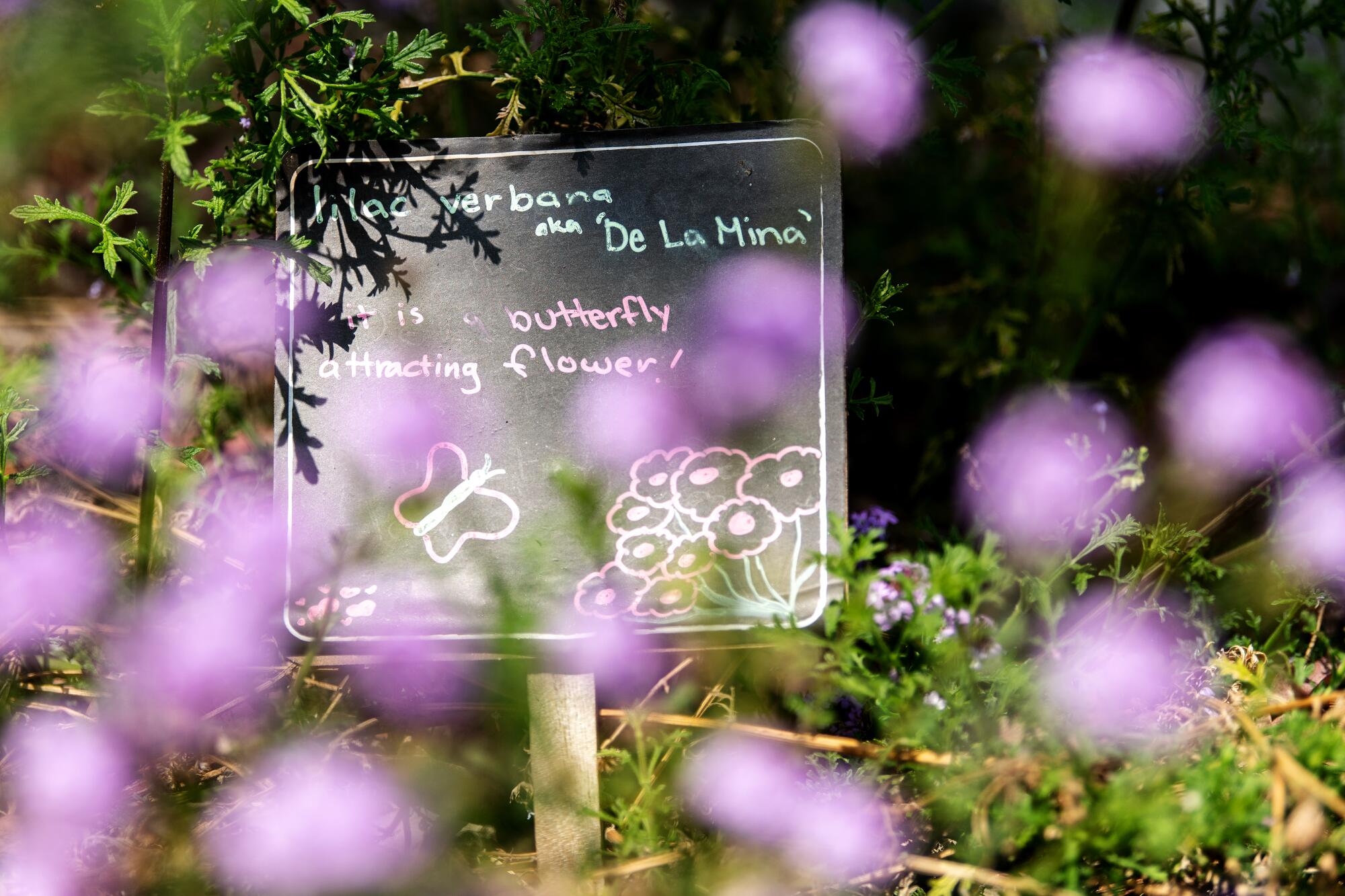

Green space can be transformative, Sherrills says as she bends down to inhale the purple blossoms of a Verbena lilacina ‘De La Mina.’ “Several survivors planted things for their loved ones here, and now they can come and check in on the plants and talk to them,” she says. “It’s like having a living altar here. I think it’s important that we continue to build altars and sacred spaces. That has always been the vision of the Reverence Project — that Watts would be a catalyst for the next peace movement.”
The Reverence Project was founded in 2014 by Sherrills’ father, Aqeela Sherrills, who grew up in the Jordan Downs housing project in Watts and was instrumental in negotiating the 1992 peace treaty between the Crips and Bloods. After his 18-year-old son Terrell was shot and killed at a party in Ladera Heights in 2004, he went on to create the Reverence Project to help survivors deal with the grief of losing a loved one to violence.
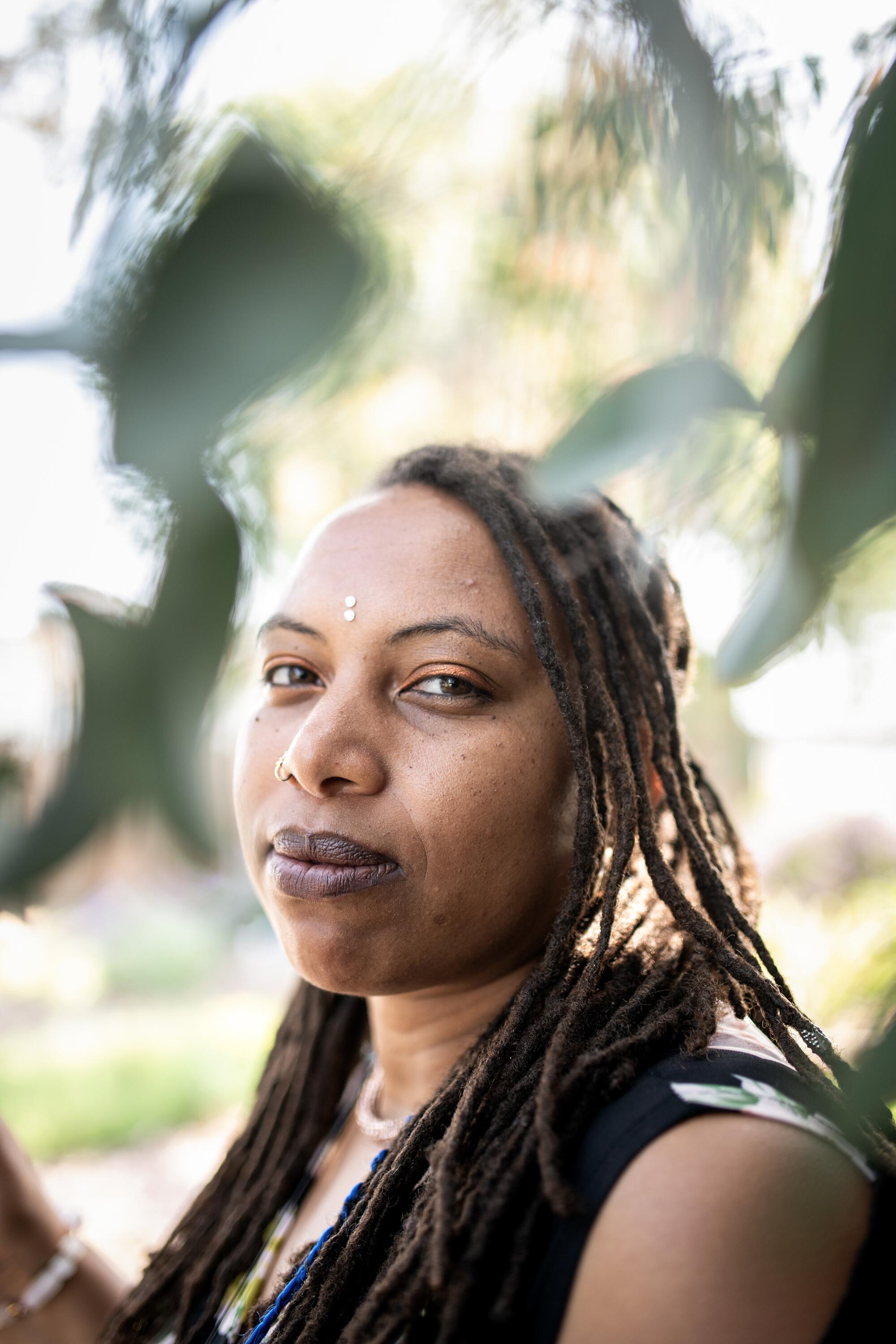
“When my brother was murdered, it caused such a disruption to all of our psyches and our feelings of safety, even though my dad and uncle had been doing peace work for 18 years,” says Sherrills, 35. “We still don’t know what happened at the party. Maybe it was the colors he had on. I heard rumors it was about a girl. We’ll never know. But it shook up our family.”
Decades of gangs and violence have long defined Watts, where nearly 42,000 people live today. Now, through the Survivors Healing Garden, Sherrills hopes to establish a community-centered narrative of peace-building that honors the concept of choosing healing over revenge.
“For us, the garden is a physical manifestation of peace,” she says. “When [people visit Watts], they should leave understanding that even a place embroiled in warfare can find peace. The same warriors [who engaged in violence here] came together to build peace. I want that to be part of my brother’s legacy, my family’s. A lot of gang members don’t want to cross the tracks. But everyone is welcome here.”
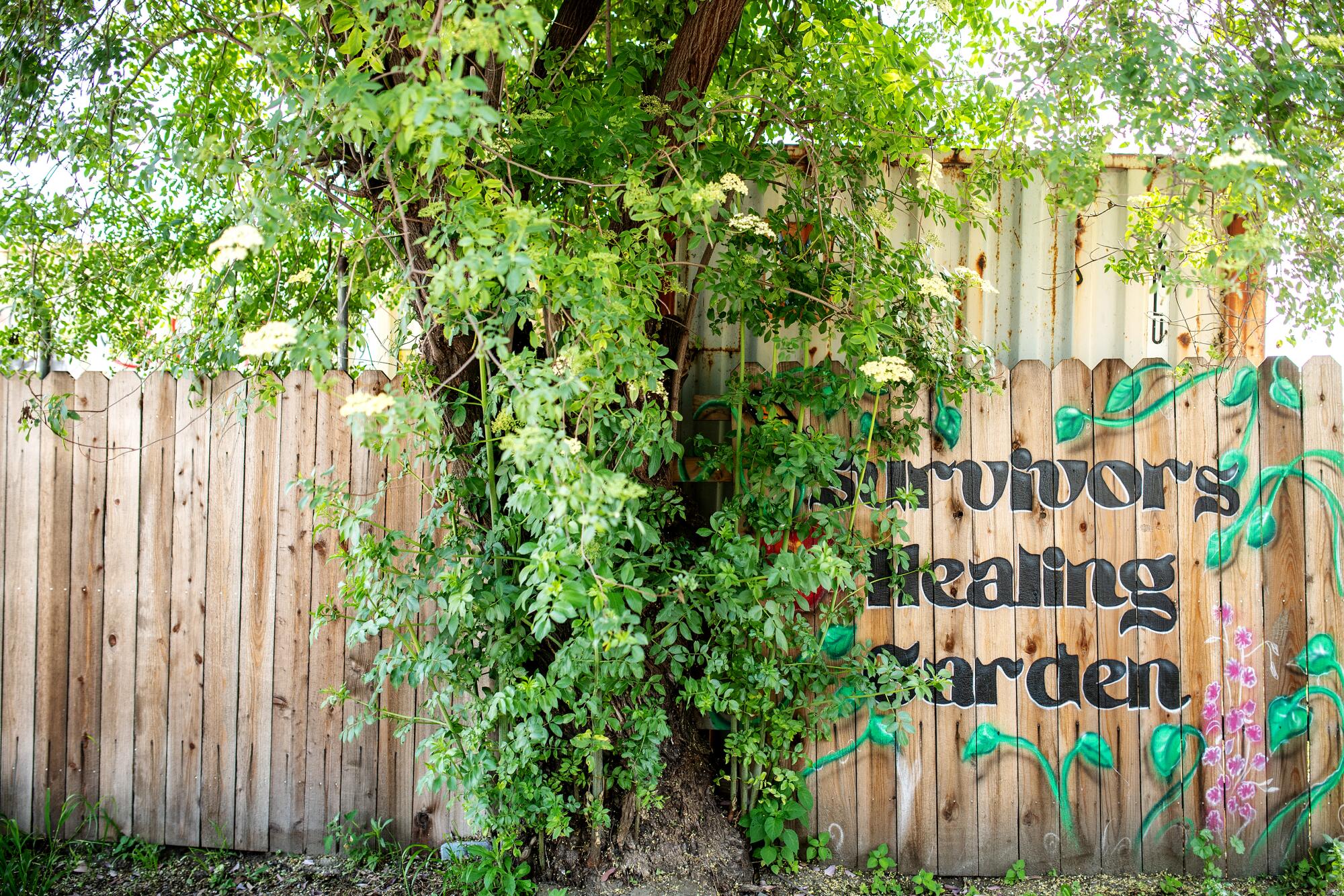
Located between four housing projects and close to many schools, the garden is strategically placed to enhance public safety.
“We chose the Survivors Healing Garden site to be right where violence intervention and prevention is needed,” says Sherrills. “A part of what we do is build community public safety strategies. We want to give people in the community access to nature to feel safe.”
The garden is another way to help survivors who are struggling to process trauma but aren’t interested in traditional therapy, says Phillip “Rock” Lester, who sits on the Watts Neighborhood Council and runs the Ambassadors Shop, a tattoo parlor and entrepreneurial and retail space that sells Watts-based apparel, accessories and artwork by local artists.
Sandra Mejia and her husband, Bantalem Adis, opened the Plant Chica to greenify South L.A. Now, they might have to leave to make way for new construction in a changing neighborhood.
“This garden is something different,” says Lester, whose uncle was shot dead by a gang member in Lester’s grandmother’s front yard in Harvard Park. “When we planted the trees, we asked survivors to embrace one of them. Some individuals dedicated trees to their children. It’s something you don’t see too often. We want to try something different by focusing on healing and providing spaces for the community to come together. “
Shot twice when he was 14 years old, Lester understands how alternative therapies like aromatherapy, massage and music therapy can alleviate more than just physical pain. “We want survivors to experience things that speak to their inner person and feed their soul,” he says.
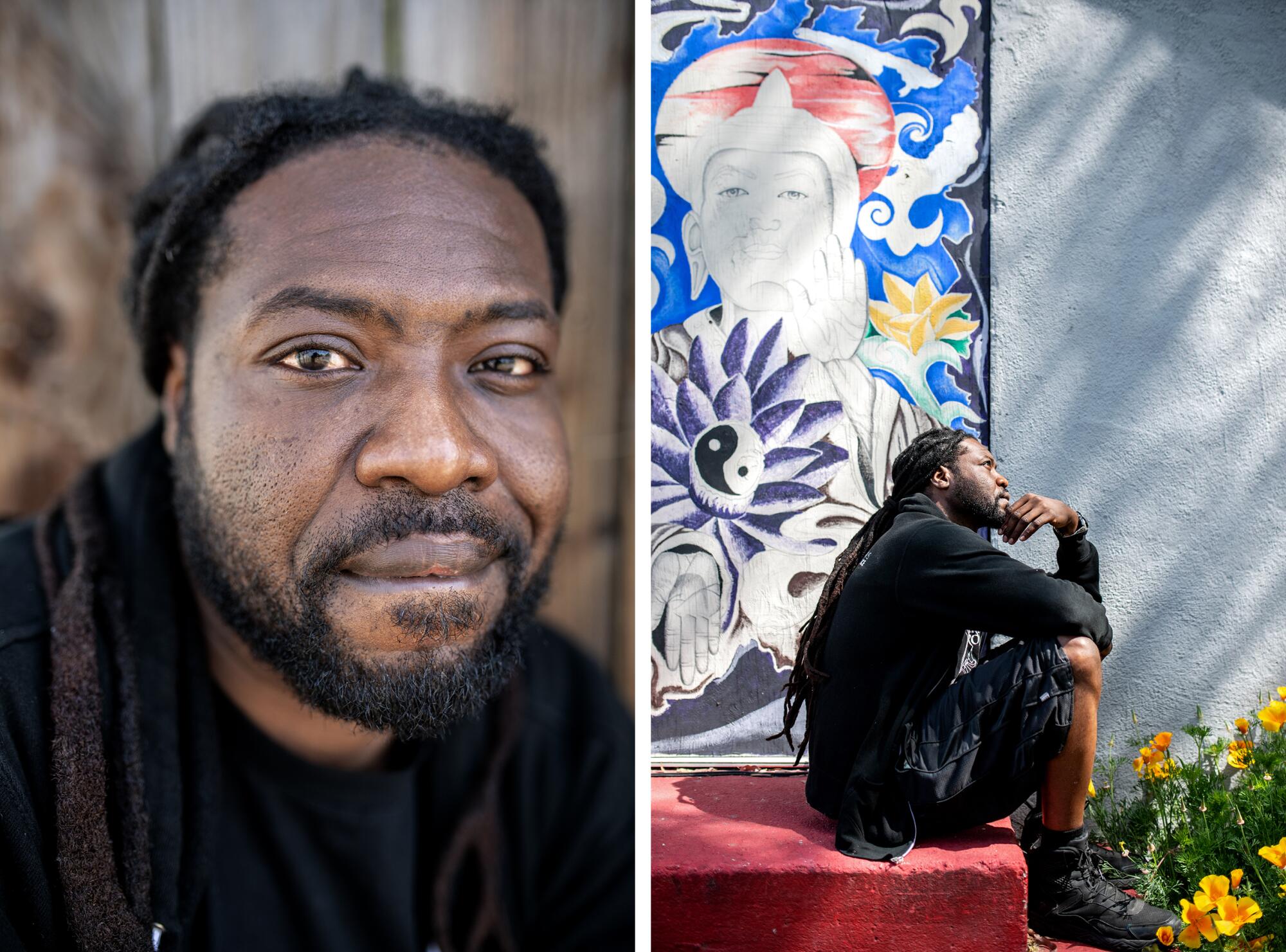
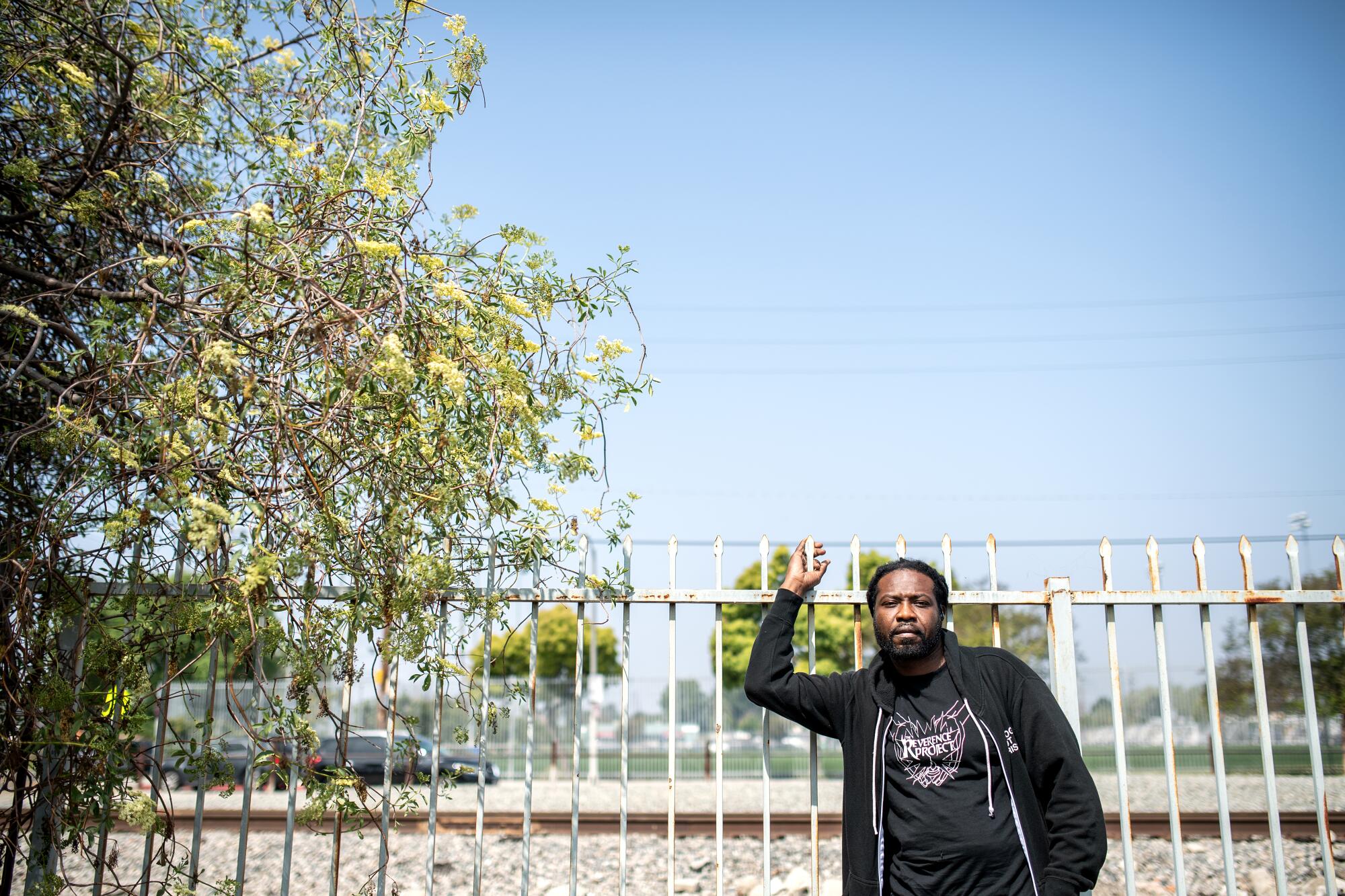
Through hands-on intervention — Sherrills at the Reverence Project several days a week and Lester at the Ambassadors Shop on 103rd Street — many residents of Watts are choosing to participate.
“They’ve helped me a lot,” says Marylin Chism, who has lost more than 10 loved ones to unsolved murders and has attended healing circles in the garden and at the beach with her mother. “You need a place of peace where you can sit and not worry. You can clear your thoughts and not sit at home and look at the walls and pictures of people who are gone. That will make you sad. It feels good to be out here.”
Rituals held in the garden, including healing circles, plate smashing and releasing lanterns in memory of loved ones, help survivors, Chism says, because they offer holistic ways to support the inconsolable.
“When I hear how some people lost their children to gun violence, I know many people have it worse than me,” says Chism, who has an 11-year-old daughter.
Death is a part of life, but losing a loved one to violence can be complex. “Some people want a reason to stay angry,” Chism says. “If you are willing to let go of your anger, you feel like you’re betraying that person or you will forget them. Hanging on to that anger keeps them alive.”
A year after receiving the grant, Sherrills has been overwhelmed by the support of Watts residents and volunteers from across Los Angeles. “It has been way more than $20,000 in funds,” she says. “The expertise we have experienced has been more valuable.”
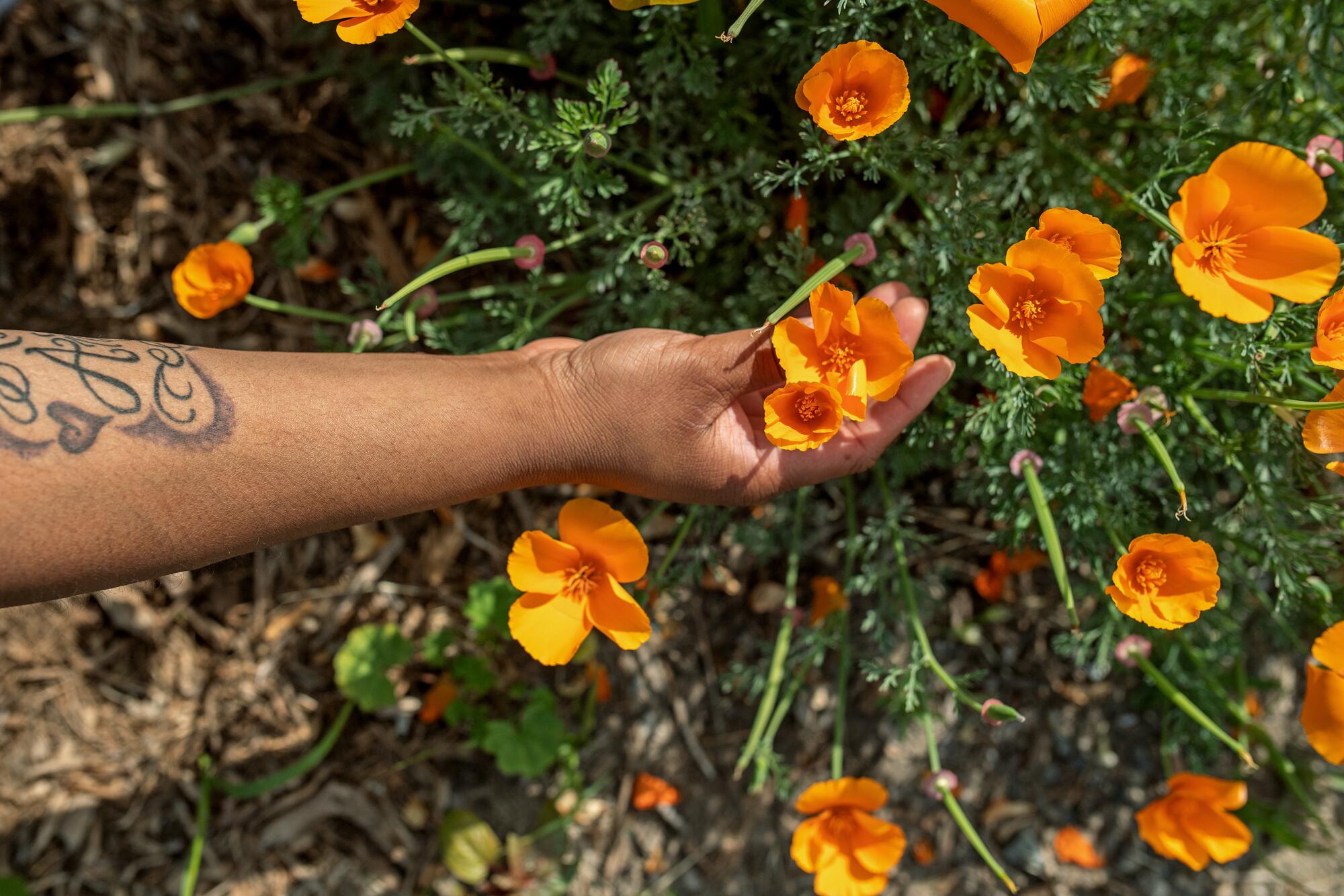

Over several weekends in June, Los Angeles architectural designers Amanda Cavallo and Karolina Rojahn and a group of volunteers built a SuperAdobe firepit designed by Ryan Serrano of Earth Steward Ecology just beyond the sunken bioswale where the Reverence Project will host healing and community circles. In the future, the designers hope to add tiles, similar to the spirit of Watts Towers, and meaningful crystals, stone, glass and metal stamps brought by survivors and community members.
“Top-of-the-line designers, landscapers, architects and project managers have helped us craft and create this environment,” Sherrills says. “Folks come out from all over L.A. and have worked alongside survivors, former gang members and youth who share their stories of growing up in Watts. They are all getting their hands in the dirt collectively. They are honoring those who they have lost while sharing experiences they have overcome [or that] brought them to their knees or made them stronger.”
Los Angeles County residents have been removing their lawns to save money and water during the megadrought.
Katie Freeze-Becker, who leads the U.S. Green Building Council-Los Angeles’ Legacy Project, says the garden project has “a special gravity in drawing people” to Watts.
“Each year, the Legacy project aims to empower local individuals, communities and organizations to implement programs that nurture sustainability and social equity within their neighborhoods to create real change,” Freeze-Becker says. “There is something sacred in this space. We get to partner in transforming the space into what it was meant to be, and that has been humbling. The site speaks volumes about the need for green space in L.A., especially in areas that have experienced divestment and discrimination. Addressing these areas is essential to our effectiveness in fighting climate change.”
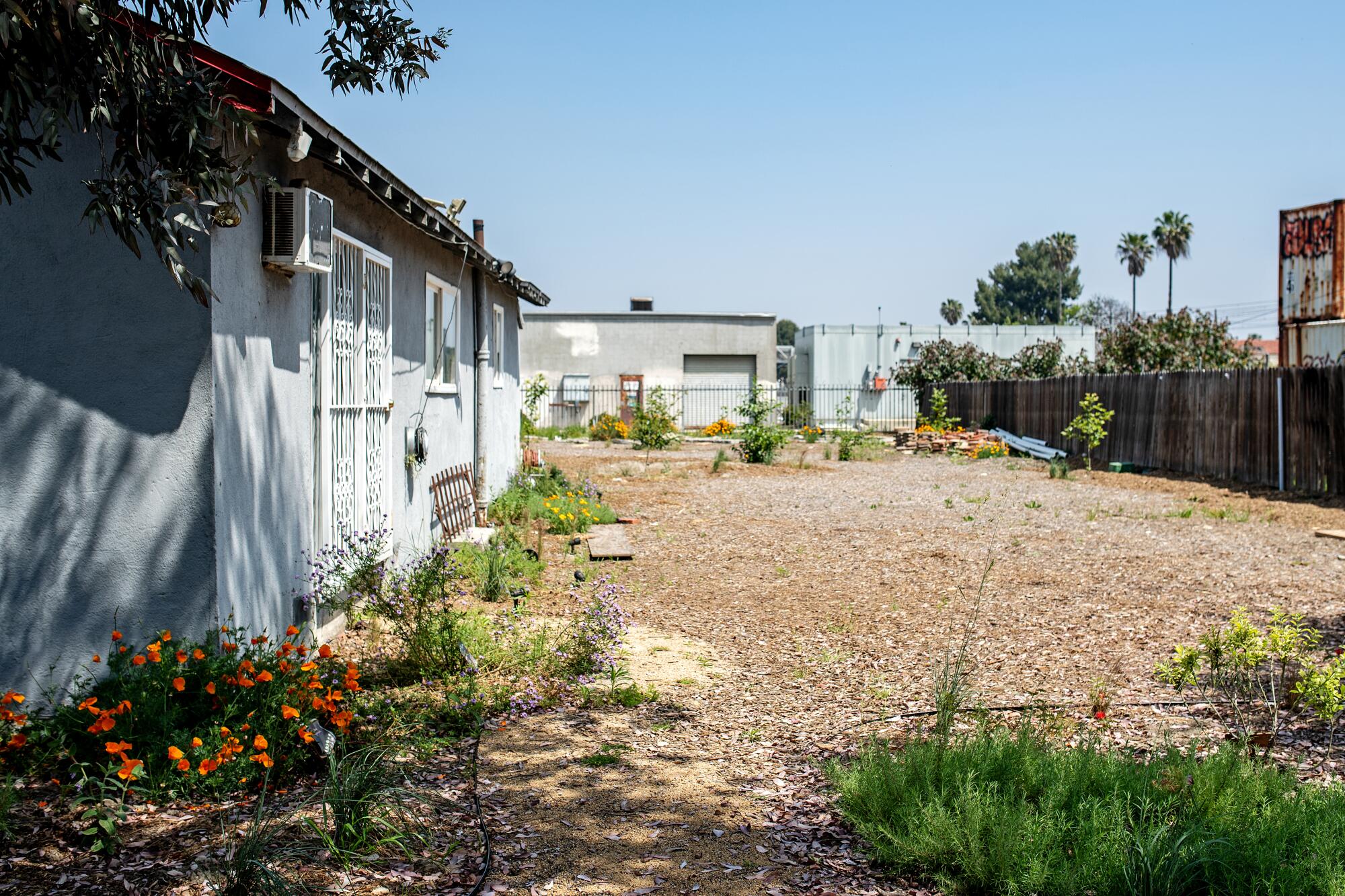
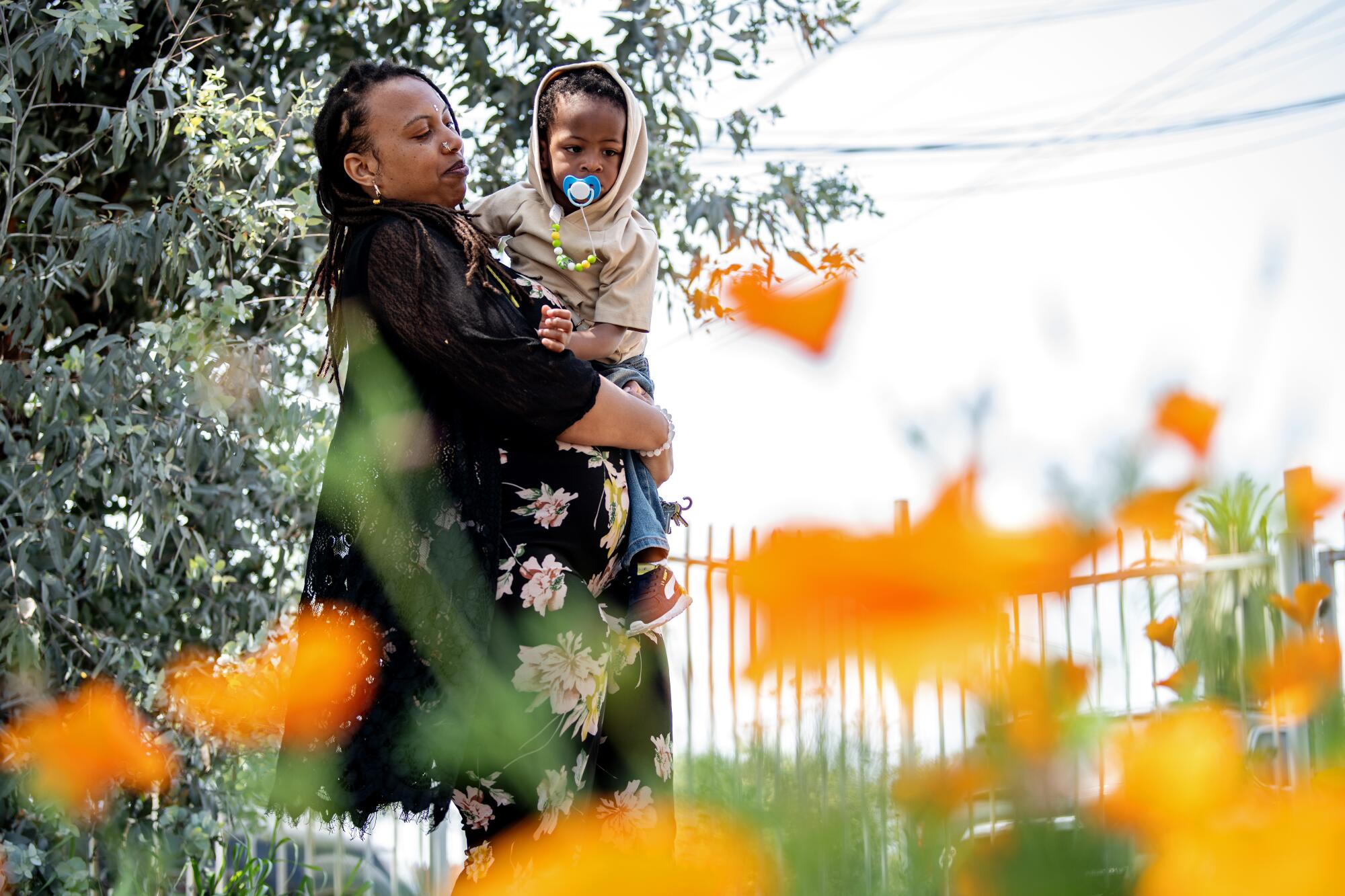
Following in her father’s footsteps, Sherrills hopes to keep the momentum going and transform the Watts corridor into a Peacebuilders Nature Walk that connects the city’s urban green spaces and builds a better future for her sons, Santiago and Justice, and all the youth of Watts.
“One park can connect to Watts Towers, which connects to another state park,” she says. “If we connect all of this, we can connect the community. These are contested areas where people have lost their lives. There is blood on these streets. If we can plant flowers, fruit trees and herbs that encourage the community to come together, we could disrupt some of the division. When we build things together, we become stronger together. Watts deserves better. This garden is a start.”
Volunteer days
The Reverence Project will host multiple volunteer events from 10 a.m. to 1 p.m. one Saturday a month through the rest of the year: July 17, Aug. 13, Sept. 16, Oct. 14, Nov. 11 and Dec. 9.
Everyone is welcome.
1673 E. 108th St., Los Angeles
thereverenceproject.com, instagram.com/thereverenceproject
More to Read
Sign up for The Wild
We’ll help you find the best places to hike, bike and run, as well as the perfect silent spots for meditation and yoga.
You may occasionally receive promotional content from the Los Angeles Times.
